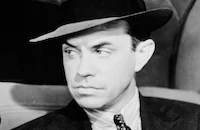Sinbad the Sailor

Brief Synopsis
Cast & Crew
Richard Wallace
Douglas Fairbanks
Maureen O'hara
Walter Slezak
Anthony Quinn
George Tobias
Film Details
Technical Specs

Synopsis
Centuries ago in Persia, at the time of Caliph Harun-Al-Rashid, boastful Sinbad the Sailor regales his doubting comrades with yet another tale of adventure: One day, near the port city of Basra, Sinbad and his faithful friend Abbu lay claim to a foundering baggala, or ship, whose crew has died from poisoned drinking water. On board, Sinbad is thrilled to discover a map he believes shows the way to Alexander the Great's legendary treasure-filled island, Deryabar. Sinbad is also excited to find a stained glass window depicting the same island scene engraved on a medallion he has been wearing since childhood. Assuming that the baggala belongs to Prince Ahmed, the lost ruler of Deryabar, Sinbad, who knows nothing about his parents, courts the possibility that he is Ahmed. Sinbad feels his destiny is to sail the ship to Deryabar and is therefore distraught when the map suddenly disappears. Before Sinbad can set sail from Basra, he learns that a newly enacted law requires that all found property must be offered at public auction before the finder can claim it. Sinbad tries to discourage any potential buyers by describing the ship as cursed and is annoyed when a veiled woman begins bidding on it. Sinbad outbids the mysterious woman, who then invites him to her home, and uses money that Abbu has pilfered from the auctioneer to pay for the baggala. Unknown to Sinbad, the woman is the beautiful but greedy Shireen, mistress to the ambitious Emir of Daibul. Shireen assumes that Sinbad, who is wearing some of the fancy clothes he found on the baggala, is Prince Ahmed and therefore must know the way to Deryabar, while Sinbad assumes that Shireen's interest in the baggala indicates that she knows the way. When Sinbad meets Shireen at her house, however, he woos her with his simple charms, and she feels her greedy desires evaporating. After Shireen warns Sinbad against pursuing the treasure, an assailant hiding behind a curtain tries to stab the sailor. Although Sinbad is unable to catch his attacker, he does secure his scimitar, which bears the inscription "Jamal," the name of a legendary underworld figure. Undaunted, Sinbad hires a crew and sets sail for Deryabar the next day. While sailing, Sinbad notices a parrot, who had led him to Shireen's house the night before, fly from his baggala to another ship and deduces that Shireen is on the ship. Ignoring the warnings of his newly hired barber, Melik, Sinbad follows the slave-driven ship to Daibul and tracks Shireen to the Emir's guarded palace. Sinbad sneaks into Shireen's quarters, but is soon arguing with her about Deryabar. Shireen becomes insulted when Sinbad accuses her of pure greed and alerts the guards to his presence. After a long chase through the palace, Sinbad is caught and brought to the Emir, who is surprised to learn that he is the "prince." While the Emir, who also assumes that the prince knows the way to Deryabar, entertains Sinbad, Sinbad performs a trick with a smoking lamp to kidnap Shireen and flee the palace. Once on board his baggala, Sinbad and Shireen both realize that the other is ignorant of Deryabar's location, and Sinbad finally confesses his true identity. Although Shireen, who grew up hearing stories of Sinbad's exploits, is impressed by his revelation, she becomes infuriated when he continues to treat her like a gold digger. Melik, who has told Sinbad that he saw and partially memorized the stolen map to Deryabar while in Daibul, then offers to direct the ship, which is being pursued by the Emir. As they steer into a fog, a traitorous sailor alerts the Emir to their whereabouts and sets the baggala on fire. Just before the Emir rams their ship, Sinbad is attacked by the traitor, and while he is unconscious, Shireen removes his medallion, which she believes is cursed, and gives it to the Emir. Alerted by Shireen that Melik knows the island's location, the Emir begins to beat the barber, then tells Shireen that to prove her loyalty to him, she must watch Sinbad slowly die. Sinbad out-maneuvers the Emir, however, and using Jamal's hidden scimitar, demands the return of his medallion. At that moment, Melik reveals himself to be Jamal, and Sinbad, captured once again, suddenly realizes that the ship is approaching Deryabar. Among the ruins of Alexander's palace, Sinbad, the Emir, Shireen and Melik meet Aga, Ahmed's father. After Sinbad shows him the medallion, Aga explains that, to protect his young son from vicious hordes of treasure seekers, he left him with sailors. The baggala, he explains, belonged to an impostor. Although the wise Aga tells the group that the treasure resides in the mind and the heart, Melik threatens to kill Sinbad unless he discloses its "true" location. Sinbad then insists that he found the medallion in a bazaar, and he and the Emir force Melik to drink from a vial they suspect contains the same poison used to kill the baggala's original crew. Because Melik is apparently unharmed by the potion, Aga reveals the treasure's hiding place and embraces Sinbad as his son. While the Emir and Melik revel in their newly found wealth, Sinbad escapes and rescues Shireen, who has confessed to loving him, from the Emir's ship. Melik then succumbs to his own poison, while the Emir is killed by a fire bomb launched at him by his mutinous slave crew. His tale completed, Sinbad laughingly shows his skeptical listeners some of Alexander's booty and sets sail with Shireen at his side.

Director

Richard Wallace
Cast

Douglas Fairbanks

Maureen O'hara

Walter Slezak

Anthony Quinn

George Tobias

Jane Greer

Mike Mazurki

Sheldon Leonard

Alan Napier

John Miljan
Barry Mitchell
Charles Soldani
Mikandor Dooraff
Chuck Hamilton
Joe Garcia
Nick Thompson

Cy Kendall
Billy Bletcher
Hugh Prosser
Harry Harvey
George Lloyd
Lida Durova
Dolores Castelli
Milly Reauclaire
Teri Toy
Joan Webster
Leslie Charles
Norma Brown
Norma Creiger
Mary Bradley
Ann Cameron
Geraldine Sutter
Angela Gregg
Amy Cordoni Leialoha
Florita Romero
Helen Tracy
Ona Chavers
Barbara Mclean
Patty Mclean
Coletta Holmgren
Jean Lind
Anna Marie Walters
Bea Narvez
Nancy Monegan
Vonne Lester
Ira Buck Woods
Lee Elson
Dennis Waters
Bill Shannon
Bruce Brewster
Joe Dixon
Eddy Hart
Wade Crosby
Gordon Clark
Jamiel Hasson
Al Murphy
Dave Kashner
Max Wagner

Glenn Strange
Norbert Schiller
Don Avalier
Bill Sundholm
Eddie Abdo

Louis Jean Heydt
Charles Stevens

Paul Guilfoyle
George Chandler
Ben Weldon
Stanley Doering
Phil Warren
Crew
Stephen Ames
C. Bakaleinikoff
George Barnes
Gordon Bau
Claude Carpenter
Carroll Clark
Albert S. D'agostino
Jimmy Dime
Frank Doyle
Capt Fred F. Ellis Ret., B.m.m.
Dwight Franklin
Gil Grau
Natalie Kalmus
Edward Killy
George De Normand
Morgan Padelford
Clem Portman
Lloyd Richards
Dave Sharpe
Darrell Silvera
Paul Singh
Edward Stevenson
Sherman Todd
John E. Tribby
Glenn Tryon
John Twist
John Twist
Vernon L. Walker
Roy Webb
Harold Wellman
George Worthing Yates

Videos
Movie Clip



Trailer
Film Details
Technical Specs

Articles
Sinbad the Sailor
A lavish RKO production beautifully shot in Technicolor by award-winning pro George Barnes (Rebecca, 1940), Sinbad the Sailor (1947) was a prestige project snapped up quickly by Douglas Fairbanks, Jr. Though famously ignored by his father as a child, Fairbanks was determined to follow in his patriarch's footsteps as a matinee idol and decided on this lush project, an ideal match between traditional swashbucklers and the more fantastic flights of fancy in films like The Thief of Bagdad (1924, one of the biggest Fairbanks vehicles). Returning from a voluntary tour of duty in the Navy, the former spouse of Joan Crawford was rewarded with one of his strongest leading roles opposite a prime leading lady. Appearing the same year in the soon-to-be-classic Miracle on 34th Street, O'Hara impressed her onscreen hero in more ways than one; ¿Her naturally reddish hair, perfect Irish complexion, and exquisitely endowed bosom (which she was wisely but discreetly at pains to exploit and which I, ever an untiring student of such anatomical addenda, discreetly admired) may not have been in the least Middle Eastern, but I didn't care,¿ remarked Fairbanks in his autobiography, A Hell of a War. ¿After all, I was not exactly a typical Arab any more than Walter Slezak was even remotely (with his taped-up blue eyes) Oriental.¿
A veteran character actor, the Austrian-born Slezak made a strong impression as the duplicitous Willy in Alfred Hitchcock's Lifeboat (1944) three years earlier. Groomed as a leading man, Slezak was often cast as the villain or cuddy comic relief thanks to his sudden weight gain after hitting 30. Often portraying characters with shifting allegiances, Slezak became a staple in prestige musicals like MGM's The Pirate (1948) and Fox's Call Me Madam (1953), as well as George Pal's splashy Cinerama spectacle, The Wonderful World of the Brothers Grimm (1962).
One of the most familiar RKO faces in the film belongs to Jane Greer, who had first caught studio mogul Howard Hughes' eye on a World War II poster. With seven films already to her credit, she made no less than three movies for the studio that year: Sinbad the Sailor, They Won't Believe Me, and a little film noir thriller called Out of the Past. Along with wrecking her marriage to crooner Rudy Vallee, her stormy relationship with Hughes kept her locked to her contract that ultimately derailed her career when the studio finally went under. Though her work output slowed considerably, she still had a few plum roles waiting such as The Prisoner of Zenda (1952), Billie (1965) and Man of a Thousand Faces (1957).
One of most memorable components of Sinbad the Sailor is its romantic, evocative music from RKO staple Roy Webb. An incredibly prolific composer, this largely unsung talent scored many of the successful Val Lewton horror films, Alfred Hitchcock's Notorious (1946), The Locket (1946), and the aforementioned Out of the Past. Though never a household name like some of his peers (Bernard Herrmann, Erich Wolfgang Korngold, Max Steiner, et al), he eventually earned an appreciative following thanks to eventual soundtrack releases over the past decade, showcasing work that often outshone the sometimes slapdash films with which he was saddled. While watching Sinbad the Sailor, you might be distracted by the gaudy visuals but the ears will find an equally rich and rewarding experience.
Producer: Stephen Ames
Director: Richard Wallace
Screenplay: John Twist, George Worthing Yates (story)
Cinematography: George Barnes
Film Editing: Frank Doyle, Sherman Todd
Art Direction: Carroll Clark, Albert S. D'Agostino
Music: Roy Webb
Cast: Douglas Fairbanks, Jr. (Sinbad), Maureen O'Hara (Shireen), Walter Slezak (Melik), Anthony Quinn (Emir), George Tobias (Abbu), Jane Greer (Pirouze).
C-118m. Closed captioning.
by Nathaniel Thompson

Sinbad the Sailor
Quotes
Trivia
Notes
The working titles of this film were The Strange Adventures of Sinbad, Strange Adventures of Sinbad the Sailor and The Adventures of Sinbad the Sailor. In 1944, Hollywood Reporter announced that the picture was to be produced by William Pereira, under the supervision of Jack Gross. RKO borrowed George Tobias from Warner Bros. for the production. Hollywood Reporter announced that Luba Malina was to have a "top role" in the picture, but her participation in the final film has not been confirmed. Douglas Fairbanks, Jr.'s role in this picture was his first following his five years in the Navy. According to Hollywood Reporter, Fairbanks used many character actors and stuntmen formerly associated with his silent movie star father, Douglas Fairbanks, including actor Charles Stevens and Dave Kashner, a bullwhip expert. Modern sources note that Fairbanks performed his own stunts in the production. The film cost $2,459,000 to make and earned a modest profit at the box office, according to modern sources.
Many films using the Sinbad character have been made, including Sinbad the Sailor, a one-reel 1919 Universal picture; a 1955 RKO sequel called Son of Sinbad, directed by Ted Tetzlaff and starring Dale Robertson; and three films with special effects provided by Ray Harryhausen: The 7th Voyage of Sinbad, directed by Nathan Juran and starring Kerwin Matthews and Kathryn Grant; The Golden Voyage of Sinbad, directed by Gordon Hessler and starring John Phillip Law and Caroline Munro; and Sinbad and the Eye of the Tiger, a 1977 Columbia release, directed by Gordon Douglas and starring Sam Wanamaker, Patrick Wayne and Jane Seymour and the animated 2003 Dream Works SKG film Sinbad: Legend of the Seven Seas, directed by Patrick Gilmore and Tim Johnson and featuring the voices of Brad Pitt and Catherine Zeta-Jones.

Miscellaneous Notes
Released in United States Winter January 13, 1947
Released in United States Winter January 13, 1947














